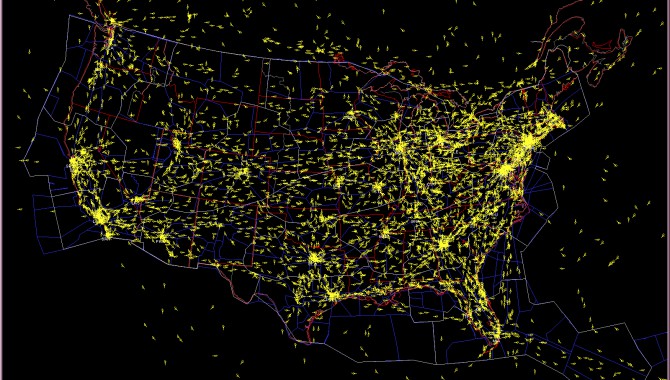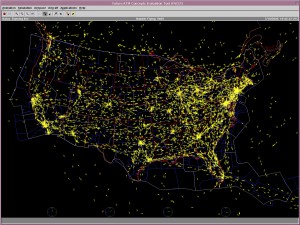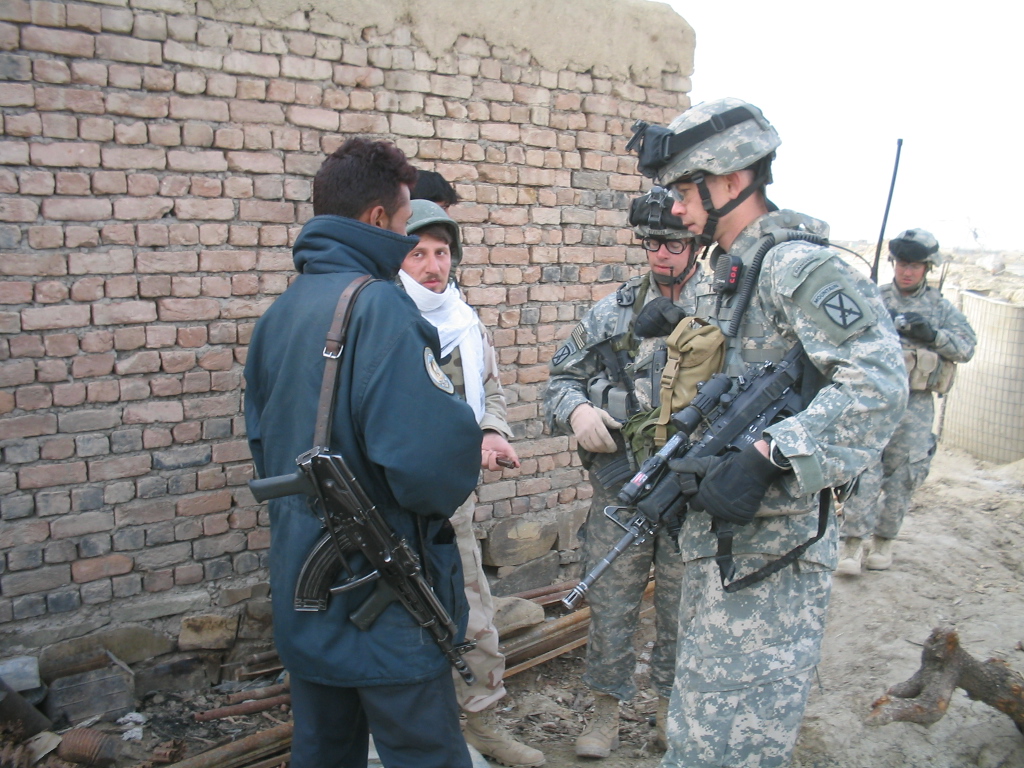
By Johanna Schultz
The Future Air Traffic Management Concepts Evaluation Tool (FACET), a unique software program used to model and predict air traffic trajectories both for research and real-time use, received NASA’s Software of the Year award for 2006. It is currently in use at more than fifty universities and licensed to more than 4,000 users in the FAA, at major U.S. airlines, and at air traffic control centers across the nation. FACET’s unique capabilities as a research and development tool will help guide development of the next-generation air transportation system.
Human interaction was the sine qua non of the creation of FACET by researchers at Ames Research Center. “It’s fairly straightforward to develop tools and functionalities; the difficulty is in making these tools useful to the people who actually do the job,” says Dr. Banavar Sridhar, automation concepts researcher and project manager for FACET. Sridhar and his team discovered that the end user’s input was the key to devising FACET’s valuable innovative features.

A FACET snapshot of air traffic over the United States on July 10, 2006, at 2:45 p.m. EST.
Image Credit: Ames Research Center
“One of the biggest surprises to me working on this project was how difficult it was to translate ideas from a research institution into actual usage. Often, what happens is that you make assumptions [based on theoretical calculations] that are hard to translate into the field,” Sridhar said. “You can figure out the algorithm, but it just isn’t going to work if you design it without the help of those who actually use it.”
While the concept may seem basic, this “listen to the consumer” approach took Sridhar and his team’s research to a new level. In fact, through extensive discussions with end users—air traffic controllers, dispatchers, and airline pilots—FACET went from a fairly straightforward research modeling tool to a real-time air traffic control tool that currently helps monitor air traffic in skies across the country.
Sridhar, together with University of California-Santa Cruz scientist Dr. Kapil Sheth and a team at Ames, was looking at the issue of air traffic control and experimenting with ways to measure a controller’s workload, or the number of aircraft that one controller at a federal air traffic control center can monitor at any one time. Initially, the team focused on an air traffic control center in Ft. Worth, Tex.—near NASA’s Houston center—but Sridhar quickly realized that the tool would have to be more comprehensive than he’d initially conceived. “In order to know how busy an air traffic controller in Ft. Worth would be an hour from now, we had to know where the aircraft were coming from,” Sridhar recalls. “Although we were interested at first in one small location, our research problem depended on everything around it, so we decided to build a tool that could see and understand air traffic control all over the United States.”
“Initially, we wanted to explore different futuristic concepts of air traffic management, but we found that in order to explore these concepts, a certain amount of realism was necessary to ensure that whatever we were doing was coming out of an environment connected to reality,” explains Sheth. “What we discovered was that people actually valued that a lot more.”
The team began approaching air traffic controllers and those involved in airline logistics, proposing functionalities and asking for input on additional features. “We had to become more customer-oriented as we moved from the research lab into an operational environment,” says Ames software developer Shon Grabbe. With every conversation, the team realized that additional functionalities and modifications were necessary.
In early discussions with users, the team realized that speed and portability were key capabilities missing from contemporary air traffic control tools. “Our goal was to think outside the box and come up with a safer system to accommodate more traffic than it does today,” explains Ames researcher Dr. Karl Bilimoria. “We thought, rather than have air traffic controllers separate the traffic, which is very workload intensive and results in a lot of bottlenecks, let’s explore a future concept in which pilots do it themselves.” Pilots currently work with their airlines’ dispatchers before take-off to generate efficient flight plans consistent with airline policy, FAA regulations, weather, and traffic conditions and to determine the appropriate fuel load.
“We wanted to answer some basic research questions on the feasibility of going from centralized control authority (current operations) to distributed control authority (possible operations in the future, say twenty years from now),” explains Bilimoria. “We are not suggesting that FACET be put in the cockpit as an operational tool to assist pilots in separating themselves from other traffic. However, it is certainly possible to use FACET as a research test-bed for developing procedures and algorithms that would make their way to a future air traffic management system featuring airborne self-separation.”
The team’s flexibility and commitment to users translated into an entirely new air traffic control system that has been commercially available through the company Flight Explorer since February 2006. FACET models the National Airspace System and enables planning of traffic flows at the national level through four separate modes of operation: playback mode, to depict and analyze historical data; simulation mode, for predicting the evolution of traffic data; hybrid mode, using historical data for playing out various “what if” scenarios; and live mode, for real-time display and analysis of actual traffic data. FACET is unique in that it is both a research and an operational tool; researchers at more than sixty universities across the country are currently using several of FACET’s capabilities, and pilots, airline dispatchers, and air traffic managers at the FAA and several major airline carriers in both the United States and Australia use FACET to make minute-by-minute decisions on air traffic flows and routing.
Unlike earlier systems, FACET can project air traffic an hour or more ahead. “When a controller separates traffic in a sector, he is looking at something that may happen within the next five to fifteen minutes,” Sridhar explains. “FACET is used to examine what happens to the system in the next one hour to several hours.”
One airline dispatcher explains the software’s unique benefits. “FACET lets me test a reroute, put that into the equation, and predict what would happen. It also helps me identify a list of flights that are going to be impacted by some constraint and suggests an optimized solution that affects the minimum number of flights, or affects a larger set of flights the minimum amount. [FACET] auto-suggests not just one reroute, but several different reroute options to shortcut the dispatcher to a good solution. It is still my place, though, to decide [whether] to move them.”
Bilimoria says, “While our primary goal was always to contribute to NASA’s research, we found and seized those opportunities to go beyond, to get some practical implications outside NASA. Software is a very useful tool, but it’s humans that are ultimately there operating it and making the decisions. It’s the software’s job to help people make better, more informed decisions. We always kept the user in mind, and in the end that really paid off.”







